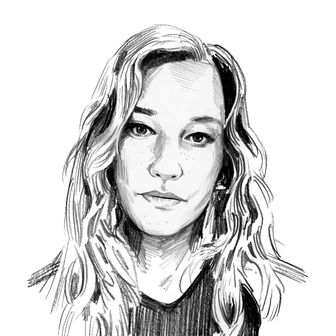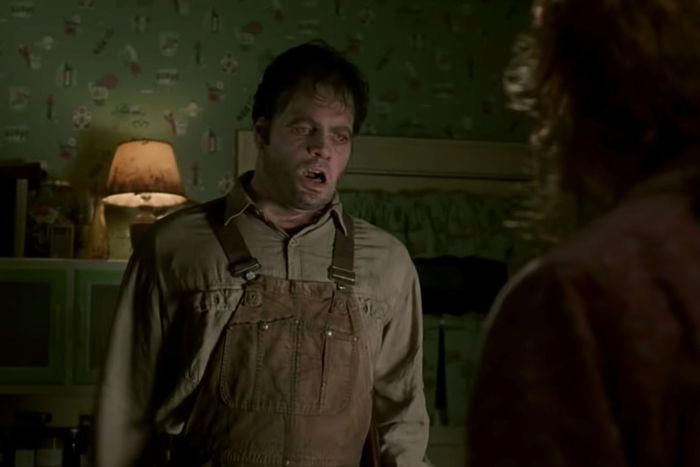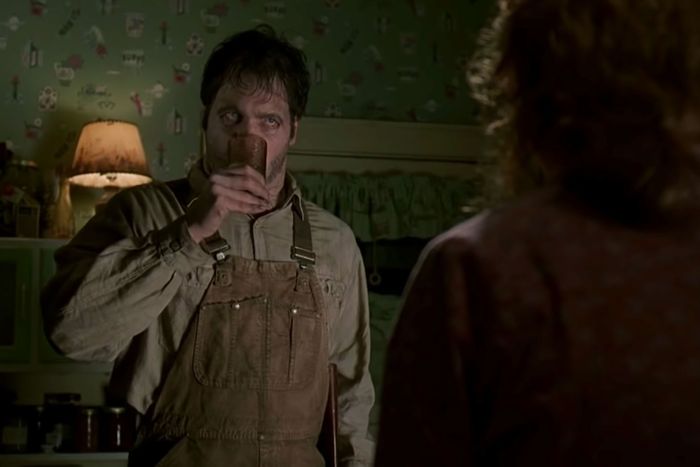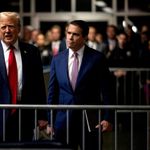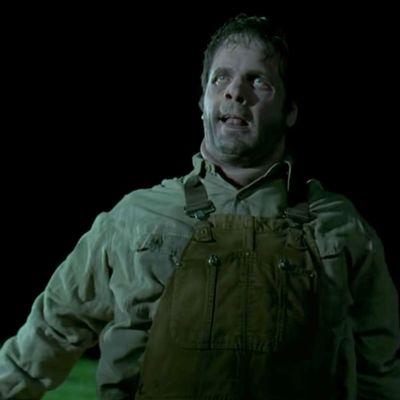
Approximately once a week, I think about a single scene from 1997’s Men in Black. Early in the film, we’re introduced to Vincent D’Onofrio as Edgar, an upstate New York farmer living in an Upside-Down version of the American Gothic house, who berates his long-suffering wife for screwing up dinner. He immediately gets his comeuppance when an alien cockroach crashes into his yard, yanks him into a hole, sucks out his entrails, pulls on his skin like a suit, and wears him around New York City.
D’Onofrio’s performance throughout the film is a work of unsound comedic genius, but what immediately follows Edgar’s death scene is particularly hilarious and haunting. Not for a minute do you forget that D’Onofrio is playing a gigantic intergalactic bug stuffed into the skin of a farmer. He lurches stiffly out of a flaming crater, bursting out of his overalls, his face stretched at unnatural angles, skin bunching beneath his chin, tongue lolling in his mouth. He yanks at his hairline, stretching his mug into an unnatural mask of wrinkles and teeth. Inside the kitchen, he grunts furiously as he pounds an entire glass of sugar water, his wife (Siobhan Fallon Hogan) looking on in disbelief. D’Onofrio is absolutely repulsive in every sense. I love it!
On the eve of the franchise’s latest entry — Men in Black: International — I finally had a good enough excuse to reach out to both D’Onofrio and Men in Black’s director, Barry Sonnenfeld, to get the story behind the scene. I wanted to know: How did they cast D’Onofrio, who at the time had yet to appear in either The Cell or Law & Order: Criminal Intent? How did they make Edgar’s face, and his entire being, so perfectly disgusting? Who came up with his walk and that voice? And, most important, do they believe in aliens, as our friends at the Times do? The actor and director graciously agreed to speak, so here is an abridged oral history of “sugar water.”
How and why did you both get involved in Men in Black in the first place?
Barry Sonnenfeld: I’d been trying to get Get Shorty made for several years, then got the script for Men in Black and read it with my wife. It’s funny, I turned to her and said, “Tommy Lee Jones,” and she turned to me and said, “Will Smith.” It was all based on her really liking The Fresh Prince of Bel-Air. But that’s not what the producers wanted. Steven Spielberg and [producers] Walter [F. Parkes] and Laurie [MacDonald] wanted, for some reason, Chris O’Donnell and Clint Eastwood. Both are great, but I left the project because the producers and I disagreed about the direction Men in Black should go. Eventually, I did Get Shorty and came back to Men in Black and convinced them to do some of the things I was looking to do.
Vincent D’Onofrio: A friend of mine, a producer, got in touch with me, and she said, “Barry Sonnenfeld is interested in you to read this script called Men in Black. The only thing is, he’s afraid you’re going to talk to him about acting. I told him I’d feel you out about it.” And I said, “I’m not gonna talk to him about acting at all.” I read the script, and I didn’t know what on earth to think of the part of Edgar. The script has nothing to do with my performance. An alien comes, he’s a giant cockroach at the end, and there’s no other description, no nothing. I found that super-intriguing. I thought, If Barry doesn’t want to talk to me about it, I probably have a lot of creative space.
What did you disagree with the producers about, Barry?
Sonnenfeld: It originally didn’t take place in New York — it was in Vegas, D.C., and Lawrence, Kansas. But it was my theory that, if there are aliens, they’d be most at home in New York because they’d fit in without a disguise. If you see a guy talking to himself in Times Square in 90-degree weather in four down jackets, he’s not crazy — it’s just that 90 degrees on his planet is really cold. The original scripts had more to do with bugs and pheromones and bugs smelling fear, stuff like that. It was too hard to execute, and it was anti-action. I believe in short movies and not a lot of visual effects. I wanted everything to be as real as it could be. We eventually came to an agreement.
I loved the story because the basic concept is we don’t have a clue. And that’s the way I feel about everything.
What was the casting process like for Edgar?
Sonnenfeld: D’Onofrio’s name came up early with the casting director, and I thought he was great. I had a meeting with him and asked him a lot of questions about Full Metal Jacket, which he’d done with Stanley Kubrick. It was so fun to hear how Kubrick worked: He made Vincent come to London and drive out to his estate once a week for months and just gain weight. He’d look at Vincent and say, “You need to weigh more. Come back in a week.” Finally, Vincent said, “Okay, now can I ask you some character questions?” And Kubrick said, “That’s your job, not mine.” I thought, Wow, if Vincent can work with Kubrick with no direction, I’ll be in a good place when I give him no direction.
D’Onofrio: The casting process was interesting. I drove to the Hamptons to meet Barry, and we just sat in the living room, spent the afternoon together, then I drove back. We never talked about the movie or anything. Then they offered me the part, I accepted, and I flew to L.A. to meet Rick Baker [who headed up the special effects and alien makeup]. Once I started the process with Rick, I really started to expand on the way I wanted to approach it, and I looked at the [concept] paintings Rick showed me — really, really early stuff people have never seen. I went to work and tried to figure out how to do the character.
What was the initial direction for the character?
Sonnenfeld: There’s very little discussion about character; it’s all about pace and attitude. He’s a bug inside a human body, but he’s way more intelligent than a human. It was all about how much he hated his wife to begin with and how much he hates his wife when he’s a bug, because she’s a human. There’s a great moment in that scene when he tries to come back into his house but he doesn’t know which side the door is hinged on, and he even gets frustrated by that. It was all about frustration — and a need for sugar.
I told him, “Always be frustrated.” He’s frustrated in the body, dealing with idiot humans. Vincent just needed to be frustrated inside his skin but never let the frustration get so big that the audience or other humans would say, “This guy is kinda weird.”
D’Onofrio: Nobody except for Rick saw the actual character or heard the character’s voice until the first day of shooting. Not even Barry. Before the first take, he met me halfway between the set and the trailer, and I showed him the walk and he fine-tuned it a little bit. He said, “Will you be able to run like that?” That was really smart of him because I was able to tailor the run and walk so that I could, in fact, move better.
We went to the set and did a take, and he cleared the set after that. He said, “So this is what you’re gonna do? That’s the voice?” And I was like, “Yeah! That’s what I got.” And he said something like, “It’s gonna be great, or it’s gonna be a complete and utter failure.” I trusted Barry, and he trusted me. It was a little scary, but we did another take, and then we did another take, and I got more and more comfortable.
The stiff walk, the way Edgar speaks, his facial expressions — where did those come from?
Sonnenfeld: That really is all Vincent — I’m so close to Kubrick as a director that I can say to Vincent, “Figure it out.” I’m kidding. But it was Vincent creating that character, in terms of his mannerisms. And then you had Rick Baker creating the fantastic prosthetics for him. His stiffness and the way he walks are because he’s a much bigger creature crammed into, as Tommy Lee says, “an Eggar suit.” That’s how Vincent came up with that great stiff walk. I’d just make sure we dialed in the amount of rage, the amount of frustration, making sure he remained flat and didn’t become a loud, big superhero-movie villain. I wanted it much subtler than that.
By the end of the Men in Black shoot, I realized Vincent was playing John Huston, specifically from Chinatown. When he’s talking to David Cross in the morgue and he says, “I left something here. A pet cat.” You can hear him doing Huston.
D’Onofrio: I was combining two voices: George C. Scott’s and John Huston’s. The first scene we shot was the one where I come in and kill the alien at lunch — where I say, “Pond scum” — and it really launched me into that voice. [Imitates Huston]: “Pond scum!” I’m sure you’ve seen Dr. Strangelove. George C. Scott has this particular raspy voice — he had it his whole career, even when he was younger. It got more and more pronounced and scratchy as he got older. He had this cadence he spoke with, which was kind of staccato. He’d put very weird pauses in and then fly out with a bit of dialogue. I was also really interested in Huston’s pronunciation of things. It was pedestrian in an elegant way. “Pooond scum.” He sounds out every letter. But I didn’t want it to be that slow, so I combined George C. Scott’s raspiness and cadence with John Huston’s enunciation.
Early on, I was looking at bug documentaries and it was such a fucking boring task. I hated it so much. I was sitting there with my roommate at the time, Steve, and at one point the camera zooms in on a beetle crossing a porch and I had to turn it off. Instead, I started to work backward, thinking about the end of the movie. If that thing was really supposed to be folded up inside me, it’d be a pretty difficult to get around. So I had my legs locked off, which was my own concoction. I went out and bought two basketball knee braces and locked off my knees and ankles so they couldn’t move up or down or to the side. The first week or so of shooting, that was under my costume. I had to force myself to move and make portions of my body react to each other involuntarily, so you knew something else was happening inside my body.
What other sort of direction did you give Vincent after seeing his initial performance, if any?
Sonnenfeld: My whole way of directing actors tends to be “Flatter, faster!” I never want to see the acting. When actors talk fast, it doesn’t give them time to act, which is a good thing. What I love about Vincent and Siobhan, who plays his wife, is — talk about flat acting — never have two actors been any flatter. Siobhan has this very monotone voice, and all Vincent is saying is, “Give me sugar in water.” Even when he says, “You can have my gun when you pry it from my cold, dead fingers,” he doesn’t blowhard it. When the alien voice responds to him, I’m pretty sure that’s Vincent’s voice. The joy of watching Vincent is how dry he is.
I didn’t want a big performance. I didn’t want a horror-movie performance. I feel comedy works best when the audience finds where the joke is, as opposed to the director or actors telling them where the joke is. I never want the actor to be funny in a comedy; I want the audience to find him funny. He was so funny because he wasn’t trying to be.
D’Onofrio: I think Barry was pretty nervous! [Laughs.] I absolutely adore Barry. Every time we see each other, we give each other a big hug. But I knew everybody was very nervous about what I was doing with Edgar. They had all this money behind this movie, and I could have fucked it up. But I didn’t want to. He wanted it to be flatter so it didn’t distract from the story, which was smart. But once we knew the performance was working, by the end we had so much fun with it. By the time we shot the sugar-water scene, Barry was very comfortable with my character.
How did you go about creating Edgar’s absolutely disgusting face?
Sonnenfeld: Rick did an amazing job of making various levels of deconstruction. Over the course of the movie, Vincent’s skin gets drier and crappier and looser, as the collagen from the human skin dries out. By the end, one of his teeth is barely dangling in his mouth. Rick did three or four different iterations, depending on where in the movie we were. Vincent totally embraced all the prosthetics and was a joy to work with. Really easy and funny.
D’Onofrio: I was so into what Rick was doing. He’s such an artist. His original designs are very close to what we ended up doing for Edgar. He’d actually take a part of my cheek and glue it to another area of my face so it pulled my entire face up — it was a trip. They’d put prosthetics on top of that. I remember Rick saying to me that because I’d lost all that weight after the Kubrick shoot, it was easier to [manipulate my face]. I was like, “Oh, that’s cool! Glad I could help!” We’d just listen to music, and I’d let Rick paint [my face]. We got into a groove together; we’d just create. It was uncomfortable, of course, but it was great to see it all come together.
What about the insane hair and overalls?
D’Onofrio: There were many different versions of my hair. The only time my real hair was used was in the first scene, before the alien takes Edgar over. From then on, it’s partially my hair, partially wigs attached to things. It evolved along with the makeup to convey the actual body dying and rotting while the bug is walking around in it. The costume was great — I saw it and was like, “Perfect! Looks like somebody who lives in upstate New York.” There’s a few versions of that costume, and they’re all owned by different people. I think Peter Jackson has one.
Who came up with the way Edgar’s wife says “Eggar”?
Sonnenfeld: Siobhan did. That was all her. Siobhan is great. I love that she calls him “Eggar,” not “Ed-gar.” She did that in her audition, and we were on the floor laughing. She brought her baby with her, too. She was just fantastic.
What a lot of people don’t notice is when Tommy Lee and Will come to her house the next day to interview her, she offers them lemonade. Tommy doesn’t take it, but if you watch Will, he takes a sip, then spits it back into his glass. The reason being there’s no fucking sugar in the lemonade because “Eggar” drank all the sugar. It’s subtle but hilarious. That was Will’s idea.
Was that actual sugar water?
Sonnenfeld: We did about seven or eight different takes from several angles of the scene, and in each one he downed an entire glass of sugar water. In a wide shot, you see him drink the entire glass full of sugar water. There’s no cutaway; he’s not faking it. By the end of that night, he had such a sugar rush because he’d drunk 11 or 12 glasses of water filled with sugar. He was a real trooper.
D’Onofrio: Barry thought that was amazing. I think I impressed him somehow. In Barry’s mind, that’s very impressive. The last time I saw Barry, he brought this up. At the screening of the last season of A Series of Unfortunate Events, we spent some time together that night, and he brought up the sugar water. I also think he just appreciates people who don’t complain.
How did you feel after drinking all that sugar water?
D’Onofrio: Like I had to pee.
At one point, the alien throws Edgar’s skin, separate from his body, up out of the hole by itself — how’d you accomplish that, effects-wise?
Sonnenfeld: We were about an hour and a half north of L.A., though it was supposed to be upstate New York. We found a place that looked like an upstate New York farm, a crappy farm with one cow. We dug that big hole. We had Vincent standing on the lip, and we shot a wide shot of him — I can’t remember if it was him or a stunt double, because we had Vincent’s faces made by Rick Baker — and had a crane lift him up in the air and pull him into the hole, which eventually became a CGI creature arm that comes out and grabs him by his head and pulls him into the hole.
Rick had made an entire Vincent D’Onofrio skin: his face, his body, his clothing. So we had someone in the hole throw that skin up onto the lip. We had to make it clear that it was Vincent’s face but it no longer had any bone structure. You don’t want to cut away. Cutting is the enemy of comedy. You want people to think it’s all happening in one shot; then you believe it. That’s why I didn’t cut to an insert of sugar being poured into the glass, either.
Vincent, was it you or a body double?
D’Onofrio: It was me for a few seconds, then a double, and I think at one point it was also a fake, a dummy.
How did you find the balance in creating a character — and a movie — that’s absolutely gross and terrifying but also funny?
D’Onofrio: That’s the task at hand! But I was inspired by the script. Reading it, you knew it wasn’t just a space movie. It wasn’t Spaceballs, it’s not blood and guts — it was something completely different. When I accepted the part, I knew Will Smith would be in it, Tommy Lee Jones would be in it; that caliber of actor coming in means you know it’s gonna be taken off the page and be even better than it is on the page. And that gave me the inspiration to make this dark, crazy thing that people had never seen before. You want people to be smiling while on the edge of their seat and thinking, What the hell is going on? Even though every performance you see is just a variation on a variation on a variation. But you try to execute it in a unique way. I know this is actor-speak, but it’s the only way I talk — I can’t help it!
Sonnenfeld: The concept of an action-adventure comedy is an oxymoron. Almost without fail, the comedy kills the reality of the action, or the action has to stop for some sort of funny line. And it doesn’t make sense. If the action is too scary or too gross or graphic, it kills the comedy. It’s a very hard line. I remember seeing Will Smith in Hancock. I loved the first two-thirds of it. I was so jealous I didn’t get to direct it. It was funny, charming. Then in the third act, the tone changes, and it becomes a darker thriller. I think the audience wants one tone. Another example of that is Bad Boys II — inside the three hours, or what felt like three hours, there are decapitations and car crashes that go on forever. But inside of those three hours, there’s an extraordinarily funny 90-minute comedy. If I’d gotten a chance to recut Michael Bay’s movie, it would have been a hilarious movie.
Tommy and Will have such good chemistry. Are there any fun stories you haven’t shared about them from the set?
Sonnenfeld: Will has really nasty farts. There’s a scene where he and Tommy Lee are driving through the Midtown Tunnel, and the car goes upside down and they’re driving on the ceiling. So we had a rig to put Will and Tommy into the car body, and then we had to seal that and turn the rig upside down on a green-screen stage in Manhattan. By the time you’d seal it, turn it upside down, and make sure it was safe, it was about 10 minutes worth of work. We finally got it upside down; we’re ready to shoot. We hear Will say, “Oh, Jesus! I’m so sorry, Tommy. Guys, get us out of here! Get us out!” And we panicked and started to turn it around, and you hear Tommy say, “No, Will, it’s okay.” And Will was like, “No it’s not! Get us out!”
He’d farted so bad in this enclosed space. Tommy is a manly man. If you talk to him about intellectual things, he says, “I’m just a rancher.” So he played it cool. But man, as soon as we opened it up, Tommy was outta there. But they loved each other. Tommy didn’t get the comedy at first; he was kind of angry that I only wanted Will to be funny. I kept explaining to him that you need a straight man, and both are equally funny. But once he saw the movie, he was so pleased by how funny he was.
What’s the question that, years later, you’re most often asked about this film?
D’Onofrio: “What the fuck were you thinking?” But usually they don’t ask me anything. They just go on about the movie. But when other artists see it, the first question is: “How did you guys come up with that character?”
Sonnenfeld: “Why did it take so long to do a second one and a third one?” I don’t know the answer. But I don’t think anyone saw this movie coming. It was so under the radar. We weren’t supposed to be the big summer movie. Unlike modern visual effects and superhero movies, it’s a very small movie. It really is a buddy movie. Even the spaceship crashing at the end, that’s all done with miniatures, not CGI. I think so many modern movies are like watching a video game. We also always observed depth of field. For example, let’s say there’s a scene with Hulk on the Golden Gate Bridge, and both he and San Francisco are in focus: That just can’t happen in nature; my brain doesn’t believe it. Lenses don’t do that. Audience brains know when it’s real and when it’s fake. Our movie is a lot of smoke and mirrors and very little action. It’s really about Will and Tommy.
Barry, you’ve said you didn’t want to work on the fourth film because “the producers and I don’t get along.” Can you elaborate?
Sonnenfeld: Truthfully, after the other three, neither Will nor Tommy nor I wanted to do any more. I wasn’t brought on, except for the first one, early enough to be involved in the development. I think the second one could’ve been better if I had been. There were a lot of disagreements, and considering that tonally and stylistically I think I had a lot to do with the success of the movies — don’t wink at the audience, don’t tell anyone it’s a comedy — I was disappointed that I wasn’t involved in the making of the others. Walter [F. Parkes] and Laurie [MacDonald] and I just didn’t get along. I like them very much as people, and if we’d never worked together I think we’d be friends. But we all have strong egos. There was no chance after the third movie that Will, Tommy, or I would ever do another of those again. I had a really good time making the first one, but the second and third were real struggles — I couldn’t get the scripts I wanted. But I wish them the best of luck.
Vincent, I love your Twitter. What inspires you to spend so much time on there talking to fans?
D’Onofrio: Movie sets, waiting around — there’s just nothing to do. You play a little ukulele, you try to be nice and socialize, and you still end up in your trailer or dressing room for most of the day. The only social media I use personally is Twitter because I like the connection, even when it’s god-awful and I quit for a few months. I like the version of honesty in it. I use it to express myself. I love to write stream of consciousness, and it’s really good for that.
Do you guys believe in aliens?
Sonnenfeld: Yeah, I thought I was making a documentary with Men in Black. I don’t know what they look like, but I believe in aliens and ghosts. You know who the aliens are. Why else would my dog, at 11 at night, go from sound asleep to sitting up and staring at the ceiling? I’ll say to my wife, “What’s that about?” I live in a rural part of Telluride, Colorado, surrounded by 67 acres. It makes no sense for me to live there, considering how afraid I am. But that dog, he’ll stop and stare, and I’ll go, “Oh, great. That’s it.” When my wife goes out of town and I’m alone with that dog? If anything happens, the building creaks, the wind picks up — why did the wind pick up?! What’s that about?
D’Onofrio: No, I don’t believe in aliens. I’d like to. And I hope to someday. That would be awesome. Right now, I don’t.
Do you think this movie is more relevant now that the New York Times is covering UFOs?
D’Onofrio: Yeah, I do. I have to say, that news footage from those pilots is really fucking interesting. I think the whole thing is freaky. But it’s just the nowadays version of what has happened in the past. I don’t know enough about what they’re showing us or how often things get picked up like that. All I know is that when you see it, it looks impossible. And yet you know it’s real. I really want to believe in aliens. We’ll see.
Sonnenfeld: Here’s what scares the crap out of me. There’s only one reason they’re letting out all these stories: We’re about to learn some really, really big stuff. And they’re just easing us into it. Why else would they do it this way? It’s like the booster shot before the big shot. They’re just getting us ready. I think it’ll be really bad.


